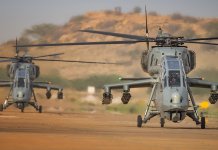Last year, the US offered India its F-21 fighter jets which New Delhi did ‘rejected’ presumably because they resembled the F-16 jets and were seen as a rebranded version of the iconic fighter aircraft.
SU-35 vs MIG-35: Two Russian Jets Compete Against Each Other For Lucrative MMRCA Contract
However, according to Defence Editor David Axe of National Interest, the F-21 merely resembles the old F-16 but rather is a new aircraft with a new cockpit display, a larger airframe spine to accommodate additional electronics and a new infrared sensor and refueling probe that is compatible with India’s Russian made aerial tankers.
However, the rebranding of F-16 to F-21 fighter jets has raised some poignant questions, one of them being at what point do upgrades turn an old fighter jet into a new one?
As EurAsian Times had reported earlier, India wants to replace its old 1960s Russian-made MiG-21s and MiG-27s. The MiG-21s are particularly prone to accidents with India reporting around 490 crashes killing 200 pilots out of the 874 MiG-21s it first brought into service in 1963.
The Indian Air Force, as reported by the EurAsian Times, has been looking to acquire new fighter jets to fly alongside French Rafales, Russian MiG-29s and SU-30s and India’s indigenously built Tejas aircraft which Lockheed Martin described as the world’s largest fighter aircraft ecosystem.
The F-21 shares many of its significant aspects with F-16V which Lockheed has sold previously to Bahrain, Greece, Slovakia, South Korea and Taiwan.
Yet, the F-21 or F-16V is different from F-16A that first flew in 1978. As compared to the F-16A, F-21 or F-16V has better radar and sensors and carries long-range missiles. But then why did the USA not call the F-16V something different?
The reason behind not changing the fighter’s name seems to be connected with cost efficacy to make the new program sound less risky. In fact, the three new F-35 variants namely F-35 A, F-35B and F-35C shared very few design elements outside of their cockpits.
All the three variants have just 20-25% commonality according to Lt Gen Christopher Bodgan. The American tendency to give old names to new aircraft created a false impression that the fighter aircraft were just the same old jets with new names.
Another example includes the advanced F-15 variant of Boeing which the company has offered to the US Air Force as F-15X and a new F/A-18E/F model that has nothing in common with its earlier predecessor F/A-18A/B.
If the Indian Air Force opts to buy the F-21 jets it would undoubtedly be able to claim to be the first operator of a brand new aircraft even if to the layman the fighter jet appears to be just another old aircraft.
Vivek Lall, Vice-President of Strategy and Business Development of Lockheed Martin had earlier said that if India decides to buy the F-21 jets then the company will not sell them to anyone else and will set up a state-of-the-art F-21 manufacturing facility with Tata Group and create an ecosystem for the overall growth of India’s defense manufacturing.
Lall said that looking from a distance, it may appear that the F-16 and F-21 are similar but actually are different. He said that F-21 had 12,000 hours of service life airframe as against F-16’s 8,000 hours and has completely different airframe, weapons capability, engine matrix and availability of engine options, according to News 18.
Earlier, Lockheed Martin inked an agreement with India’s Public Sector Undertaking Bharat Electronics Limited to explore opportunities in the F-21 fighter jet program.




